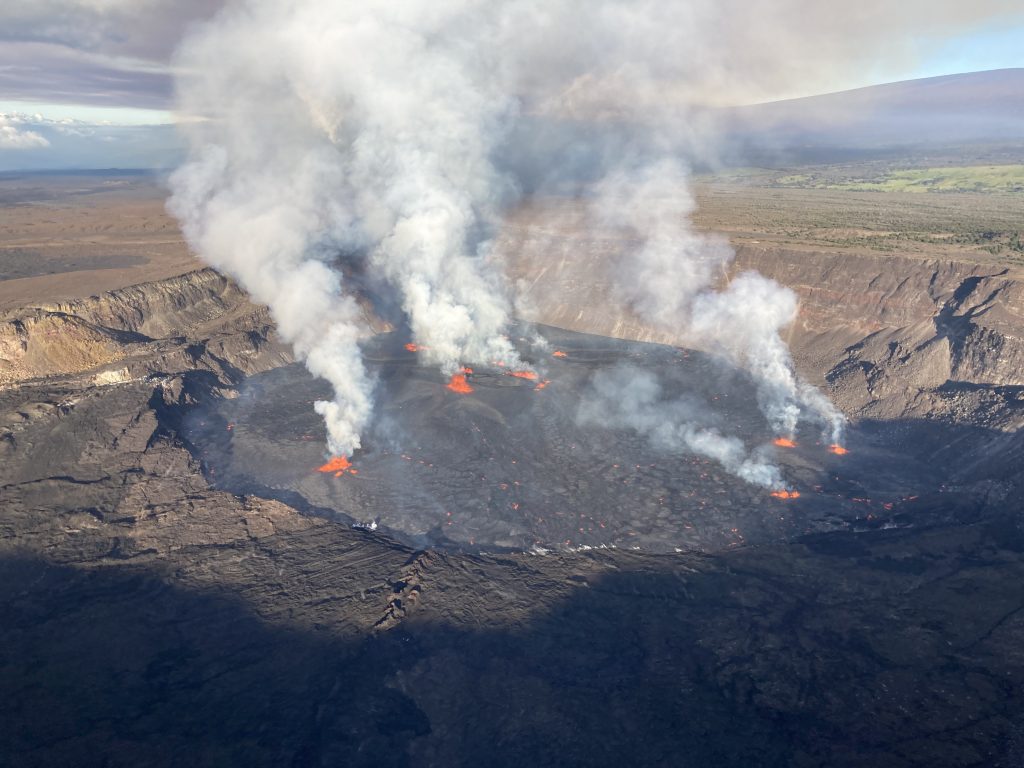Update: Hawaiian Volcano Observatory lowers alert levels for Kīlauea; expects eruption to stay at summit

Editorʻs Note: This story has been updated with new information at 9:50 p.m. on June 8.
On Thursday morning, one day after Kīlauea began erupting at 4:44 a.m. on Wednesday, Hawaiian Volcano Observatory has lowered Kīlauea’s volcano alert level from warning to watch because the initial high effusion rates of lava and gas have declined, and no infrastructure is threatened.
Associated hazards are confined to the closed area established by Hawaiʻi Volcanoes National Park.
The observatory has lowered Kīlauea’s aviation color code from red to orange because there is currently no threat of significant volcanic ash emission into the atmosphere outside of the hazardous closed area within Hawai‘i Volcanoes National Park.
Multiple minor fountains remain active in the central eastern portion of Halema‘uma‘u crater floor and one vent is open above the crater floor on the west wall of the caldera.
Lava fountain heights have decreased since the eruption onset, but remain up to 33 feet high. Active lava covers much of the crater floor (about 370 acres).
After an initial rise of about 20 feet depth of new lava added to the crater floor (measured by laser range finder), the lava level has decreased over the past day by 6 feet, likely due to gas loss. Originally, the report was of 32 feet of new depth.
This drop left a “bathtub ring” of cooled lava along the cliffs at the edge of the crater floor. An average effusion rate of approximately 150 cubic meters per second is estimated for the eruption’s first 24 hours, which is based on the rise in the lava lake level and assuming a flat surface. But this estimate is likely inflated and doesn’t account for vesiculated lava (with cavities) and variations in topography across the surface of the crater floor.
The very earliest phases of this eruption appears to have an effusion rate that was significantly higher than the previous three Kīlauea summit eruptions based upon the rapid coverage of the entire crater floor.
The effusion rate has since declined and a refined estimate will be provided when overflight data is reduced. A live-stream video of the crater is available here.
The eruption plume continues to rise to the base of the inversion level at about 8,000 to 10,000 feet above sea level as it did on Wednesday. The plume is largely composed of sulfur dioxide gas and minor volcanic particles, but in lower concentrations due to the drop in effusion rate. Hazards associated with the eruption are limited and are described below.
Kīlauea’s summit eruption is expected to continue and remain confined to Halemaʻumaʻu crater within Hawai‘i Volcanoes National Park. Scientists do not see any indication of activity migrating elsewhere on Kīlauea volcano and expects the eruption to remain confined to the summit region.
Hazard Analysis:
The eruption at Kīlauea’s summit is occurring within a closed area of Hawai’i Volcanoes National Park. Therefore, high levels of volcanic gas are the primary hazard of concern, as this hazard can have far-reaching effects downwind.
Large amounts of volcanic gas — primarily water vapor, carbon dioxide and sulfur dioxide — are continuously released during eruptions of Kīlauea volcano. As sulfur dioxide is released from the summit, it will react in the atmosphere to create the visible haze known as vog (volcanic smog) that has been observed downwind of Kīlauea.
Vog creates the potential for airborne health hazards to residents and visitors, damages agricultural crops and other plants and affects livestock. For more information on gas hazards at the summit of Kīlauea, click here. For vog information, click here.
Additional hazards include Pele’s hair and other lightweight volcanic glass fragments from the lava fountains that will fall downwind of the fissure vents and dust the ground within a few hundred yards of the vent (s). Strong winds may waft lighter particles to greater distances. Residents should minimize exposure to these volcanic particles, which can cause skin and eye irritation.
Other significant hazards also remain around Kīlauea caldera from Halemaʻumaʻu crater wall instability, ground cracking and rockfalls that can be enhanced by earthquakes within the area closed to the public. This underscores the extremely hazardous nature of Kīlauea caldera rim surrounding Halemaʻumaʻu crater, an area that has been closed to the public since late 2007.
For discussion of Kīlauea hazards, click here.
Sponsored Content
Comments








